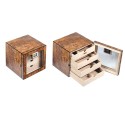The aging of cigars
Properly storing cigars is essential to preserve them in the state in which we bought them.
This is why we use the humidor, which is necessary to maintain the desired level of humidity (avoiding mold or dryness).
Some cigar smokers consider the humidor to be more than just a cigar storage tool. In fact, some suggest letting cigars rest for months before consuming them, or in some cases, even years.
In this article we will find out whether or not aging cigars in humidors can improve the smoking experience.
What is cigar aging?
There are many enthusiasts who find aging favorable for tasting, just as it is for wine.
Indeed, a prolonged fermentation process results in a change in the composition of tobacco compounds, softening the harsh notes and providing a more refined smoking experience.
But cigar fermentation begins as early as the cigar is made, with temperature and humidity levels that prevent the formation of mold or dryness.
Cigar aging begins once the tobacco has been cured to a stable storage level, with consistent temperature and humidity, for the time needed for the breakdown of organic compounds.
But beware: not all cigars are the same; in fact, aging will be more or less close between one cigar and another.
Just as with cheese, aging cigars the DIY way can be risky, especially if you do not have a reliable humidor.
What is certain is that the degree of humidity must be adequate, specifically constant and slightly lower than standard, otherwise you risk irreparably ruining the smoking experience.
Understanding the length of aging is not easy, so we report the four main stages of cigar aging.
The stages of cigar aging
The first stage, also called the sick period, ranges from 3 to 12 months and is the period when the cigar contains a large amount of ammonia, generated during the fermentation period.
It is not recommended to smoke the cigar during this stage because it is harsh and acidic. On average, cigars are sold at the end of this stage, but if you should find the presence of ammonia, it is advisable to store them longer in the humidor.
The second stage is the first maturation, lasting between 1 and 5 years. Much of the ammonia should be undetectable or chemically present in small traces. The cigar produces a substantial amount of smoke, due to the ample presence of oils, and the flavors are easier to distinguish.
This is the ideal stage for the neophyte smoker, who has the ability to recognize the cigar's aromas and flavors more easily.
Next comes the third stage, the second maturation, lasting between 5 and 15 years. Over such a long period of time, the flavor tends to become more nuanced as the tobacco and compounds continue to degrade. Ammonia is absent and the acids decompose, interacting with the purified flavors.
Many consider the second maturation to be the diminishing stage in the yield of most cigars. Longer aging can be beneficial for cigars of a certain quality and type.
The last stage is the third maturation, ranging from 20 years onward, in which vintage cigars are placed. You cannot age any cigar for more than 20 years, because not all are intended to be stored for that long. But those cigars that maintain their integrity develop more complex flavor notes as they age.
The seasoning of cigars
But how does the aging of cigars take place before they are sold?
In the cigar curing process, the tobacco leaves are cured in various ways: by fire, air, sun or chimney.
This curing causes a chemical process, which leads to the breakdown of organic compounds in the tobacco leaf.
This removes moisture from the tobacco to allow it to age without forming mold, while the breakdown of the organic compounds generates the flavors in the cigar.
Once the tobacco leaves have been cured, they are stacked in pilons, where they generate heat and release ammonia and moisture. This is the actual fermentation stage, which makes the tobacco smokable.
Aging cigars at home
Not all cigars need to continue aging, because they have already been aged to some extent by the manufacturer. But should you detect ammonia levels, you can proceed to age them further in your humidor.
Our first tip is to maintain a slightly lower than average humidity level, perhaps between 60 and 66 percent, and avoid overloading the humidor with too many cigars.
Finally, make sure your humidor has a calibrated and working hygrometer and that you do not remove the cellophane (if any) that surrounds the cigar.





